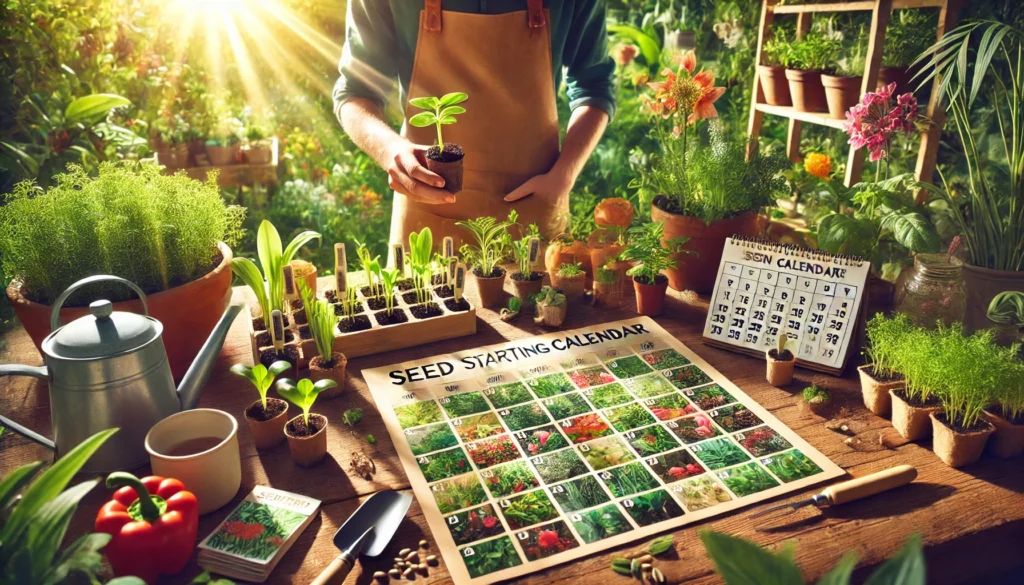
Seed Starting Calendar Guide: Perfect Timing for a Thriving Garden
Starting seeds at the right time is crucial for a successful garden, but how do you know when to begin? A seed starting calendar guide can be your best tool to ensure your plants thrive from the very first sprout. Whether you’re a seasoned gardener or just beginning, understanding the ideal sowing times for each plant type is essential for a bountiful harvest. In this article, we’ll walk you through the best practices, key timings, and helpful tips for using a seed starting calendar to set your garden up for success. Ready to grow healthy, vibrant plants? Let’s dive in! 🌿
Table of Contents
Toggle🌱 Why Timing Matters in Seed Starting 🌸
Timing is crucial when it comes to seed starting. Planting seeds at the right time ensures your plants have enough time to grow, develop, and thrive. Start too early, and you risk overcrowding your space or having weak seedlings. Start too late, and your plants may not reach their full potential before the growing season ends. 🌼

Here’s why the timing matters: 🌿
🌾 Optimal Germination Conditions 🌞
Different seeds have specific temperature and light requirements for germination. 🌻 Planting at the right time ensures these conditions are met for healthy growth. 🌱
❄️ Avoiding Frost Damage 🧊
If you start seeds indoors too late or transplant them too early, frost can damage or kill young plants. Timing your planting to avoid the last frost date helps ensure your plants survive and thrive. 🌻
🌞 Maximizing Growing Season 🌿
Starting seeds at the right time gives your plants the longest possible growing season. 🌷 This is especially important for vegetables and flowers that need a full season to reach maturity. 🌼
🌱 Transplant Success 🌸
Proper timing helps your seedlings become strong enough to be transplanted outdoors without shock. Starting too early can lead to leggy seedlings, while starting too late may give them too little time to grow strong roots. 🌳
By understanding the importance of timing, you can optimize your seed starting process and set yourself up for gardening success! 🌻
📅 What is a Seed Starting Calendar Guide? 🌱
A Seed Starting Calendar Guide is a practical tool that helps gardeners plan the best time to start seeds indoors before transplanting them outdoors. 🌿 It’s essential for maximizing your garden’s potential, ensuring that plants are started at the right time to thrive in your local climate. 🌸
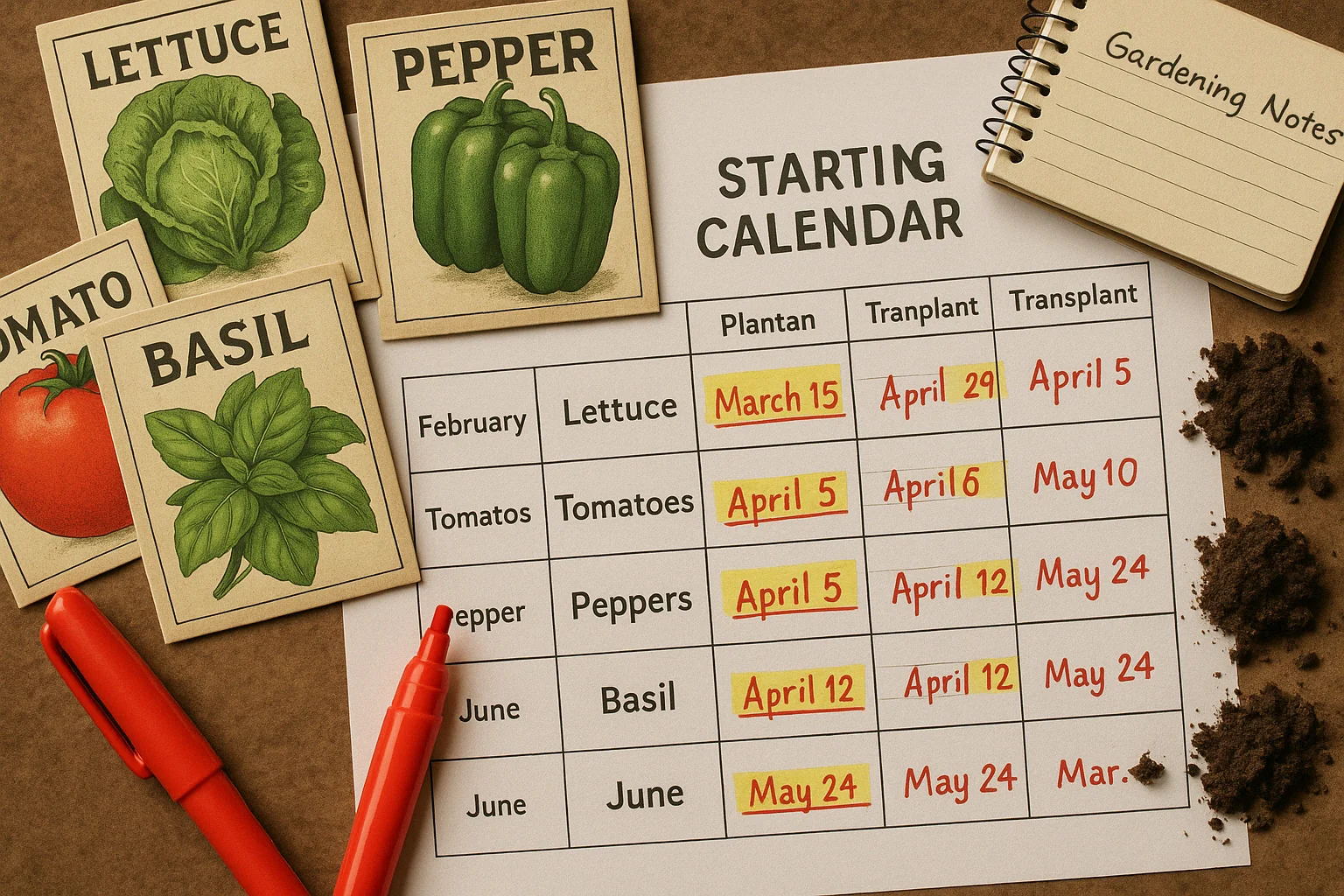
This guide outlines the specific dates for sowing seeds indoors, transplanting seedlings, and when to direct sow seeds outdoors. 🌻 It takes into account your region’s last frost date, growing season length, and specific plant requirements. By following a seed starting calendar, gardeners can avoid planting too early or too late, giving plants the best chance to grow strong and healthy. 🌱
🌸 Key benefits of using a Seed Starting Calendar Guide 🌿
- 🌱 Optimal Timing: Knowing the best times to start seeds indoors and outdoors ensures proper growth. 📅
- 🌻 Region-Specific: Tailored advice for different USDA hardiness zones, making it relevant for your local conditions. 🌳
- 🌷 Efficiency: Helps gardeners make the most out of their growing season, reducing the risk of poor yields. 🌼
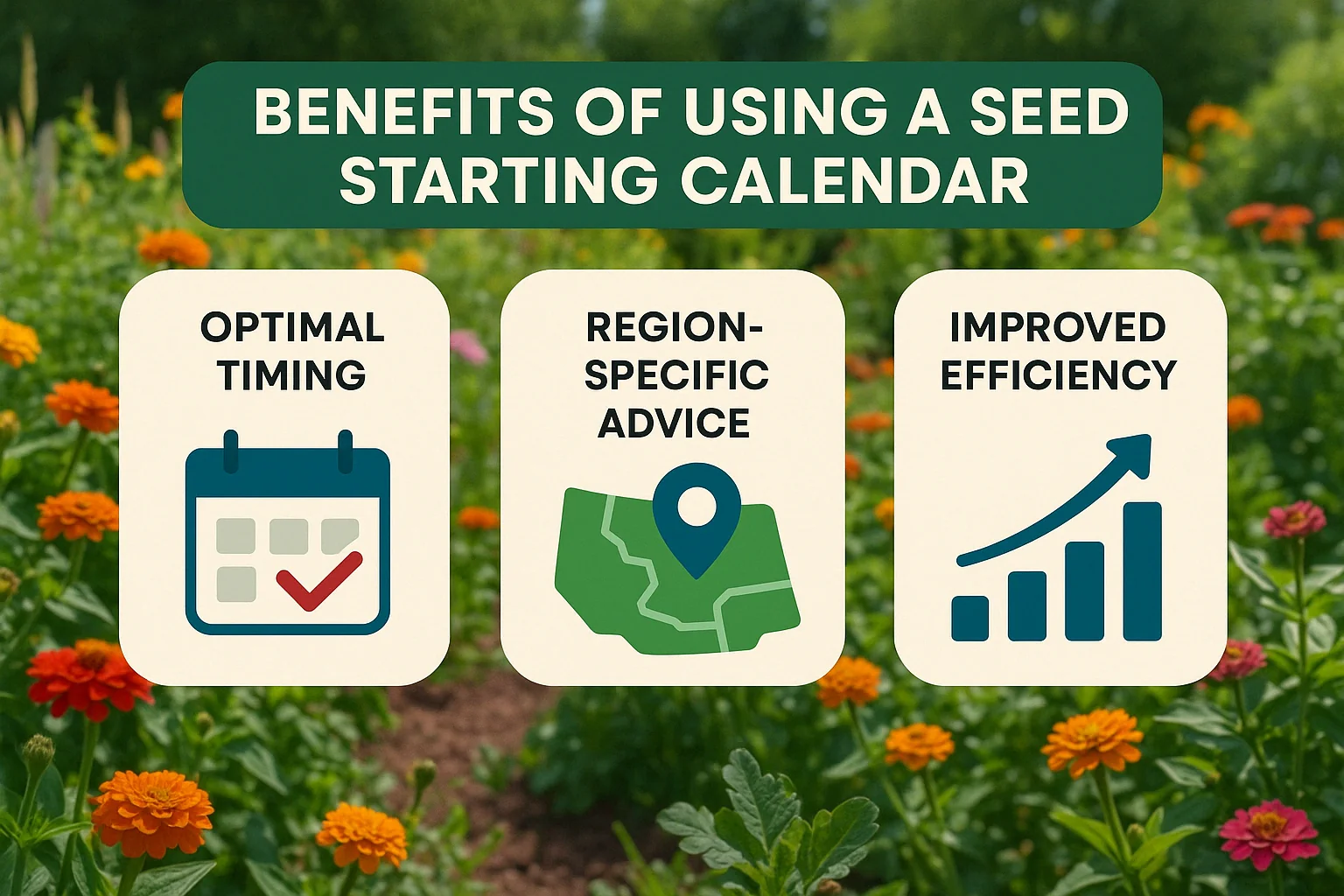
In short, a Seed Starting Calendar Guide is an indispensable resource for any gardener who wants to grow healthy, thriving plants by starting them at the right time! 🌱
🗓️ Key Considerations for Creating Your Seed Starting Calendar 🌼
Creating a seed starting calendar is crucial for successful gardening, and understanding the key considerations ensures your plants get the best start. Here’s what you need to keep in mind: 🌻
1. 🌿 Know Your Last Frost Date 🌷
Your seed starting schedule should be based on the average last frost date for your region. 🌸 This date helps you determine when to start seeds indoors and when it’s safe to transplant them outside. Check local gardening resources or use online tools to find your area’s average frost date. 📅
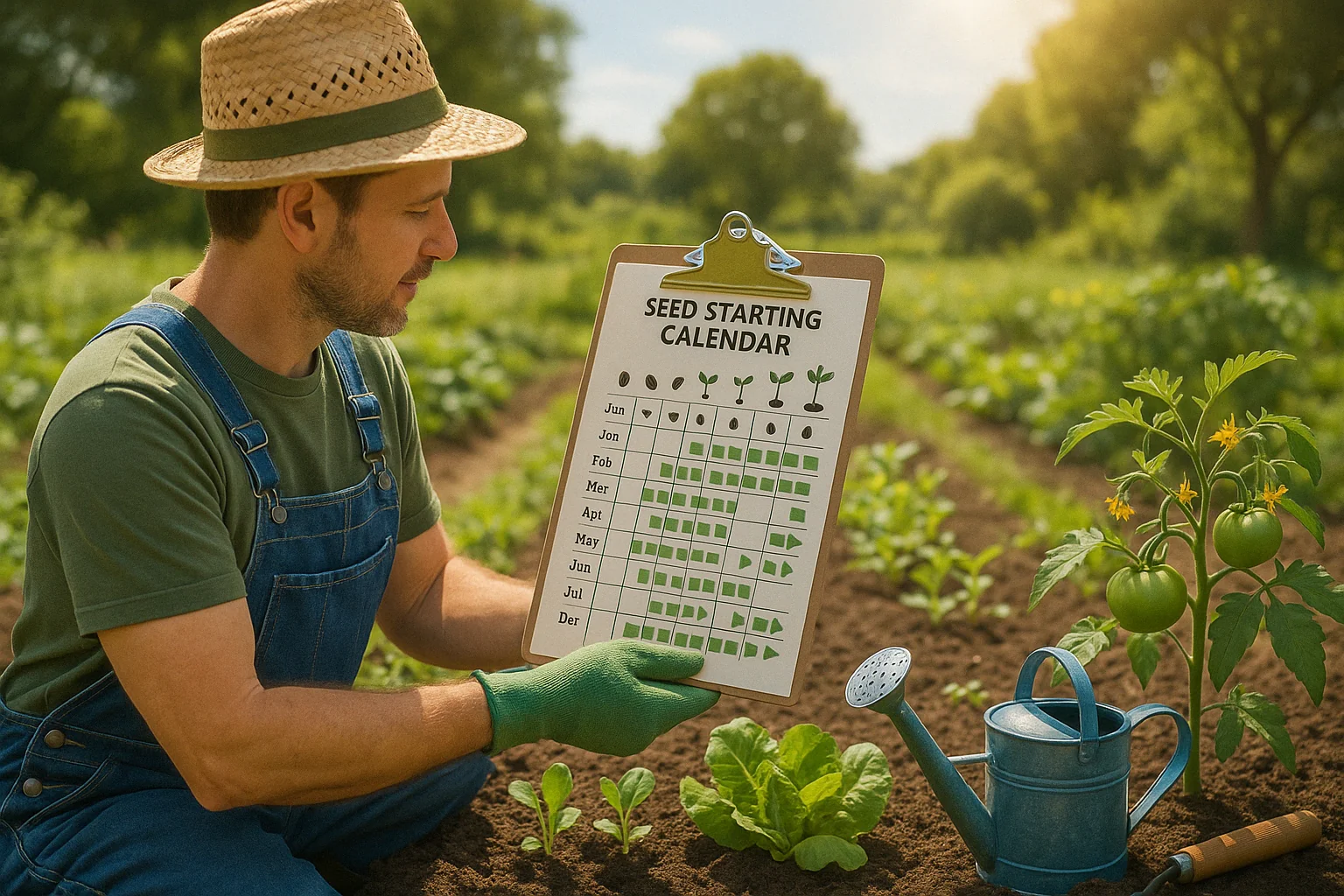
2. 🌱 Planting Times for Each Crop 🍅
Different plants have varying needs. For example, warm-season crops like tomatoes should be started indoors 6–8 weeks before the last frost, while cool-season crops like lettuce can be started earlier. 🥬 Research each plant’s ideal start time to ensure you’re not too early or late. 🌷
3. 🌸 Growth Duration 🌿
Each seed has a specific germination and growth period. 🌼 Make sure to factor in the time it takes for your seedlings to grow strong enough for outdoor transplanting. Some plants, like peppers, need a longer indoor growing period, while others, such as beans, can go straight into the ground once temperatures warm up. 🌱
4. 🌞 Hardening Off Period 🌸
Before transplanting your seedlings outside, they need a hardening-off period of 7–10 days. 🌷 Gradually expose them to outdoor conditions to avoid shock. Plan this into your calendar to avoid rushed transplanting. 🌿
5. 🌻 Local Climate Conditions 🌤️
Your local climate plays a big role in seed starting. If you live in a region with short growing seasons, consider starting seeds earlier indoors to make the most of your summer. 🌞 In milder climates, you may have more flexibility with timing. 🌸
6. 🌱 Regular Adjustments 📅
The weather can vary from year to year, so be prepared to adjust your calendar as needed. Monitor local conditions closely and keep track of your previous year’s planting dates to improve future planning. 🌳
By considering these factors, you’ll create a more accurate seed starting calendar, leading to healthier plants and a thriving garden! 🌱
📝 Step-by-Step Guide for Creating a Seed Starting Calendar 🌼
Creating a seed starting calendar is essential for timing your planting process and ensuring a successful garden. 🌿 Follow these steps to set up your own personalized schedule:
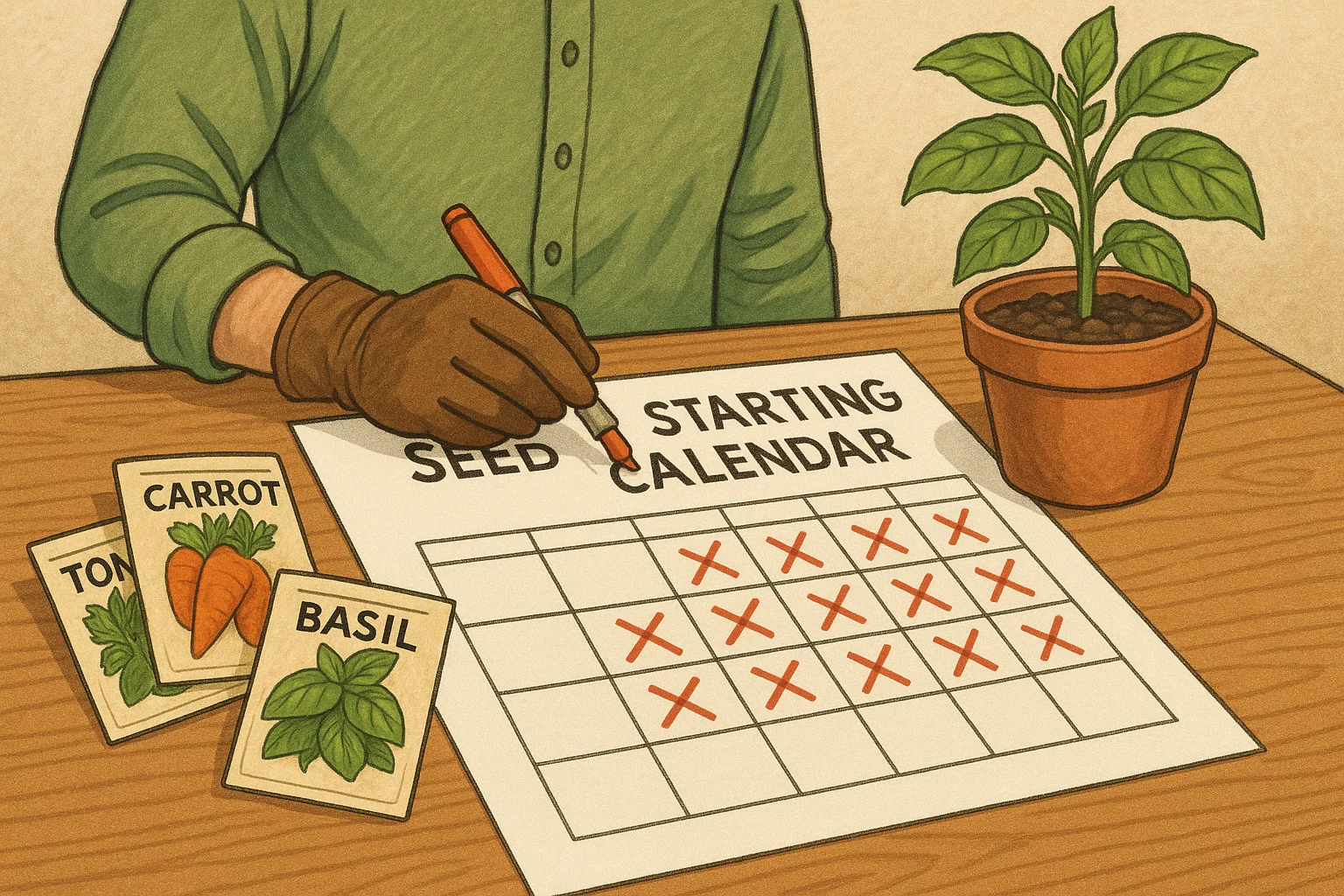
1. 🗓️ Know Your Last Frost Date 🌷
Start by determining your area’s average last frost date. 🌸 This is crucial because it helps you understand when it’s safe to plant seeds outdoors. Use local gardening resources or websites like the USDA Plant Hardiness Zone Map for accurate frost dates. 📅
2. 🌱 Understand Planting Times 🌼
Different plants have unique growing requirements. 🌸 Some seeds should be started indoors weeks before the last frost, while others can be directly sown outside. Check the seed packet or do some research to understand the ideal planting time for each type. 🌿
3. 🔄 Plan Backwards 🔄
Once you know when the last frost occurs, work backward from that date. For example, if you need to start tomatoes indoors 6 weeks before the last frost, count 6 weeks back from your last frost date to know when to begin. 🗓️
4. 📅 Create a Calendar 🗓️
Use a simple calendar or spreadsheet to list your plants and their ideal start dates. Mark each plant’s indoor starting time, outdoor planting date, and harvest window. This gives you a clear visual of your garden’s timeline. 🌸
5. 🌿 Adjust for Your Growing Zone 🌍
If you’re in a colder zone, you may need to start seeds earlier. Conversely, in warmer zones, you can plant later. Adjust your calendar to suit your region’s climate. 🌱
6. 🌞 Monitor and Adjust 🌻
Once you’ve created your calendar, keep track of your plants’ progress. Weather conditions may cause you to adjust planting dates, so stay flexible and make necessary changes. 🌷
By following these steps, you’ll have a well-organized seed starting calendar that ensures a successful gardening season. 🌱 Stay on top of your planting schedule and watch your garden thrive! 🌸
🌱 Month-by-Month Seed Starting Timeline 🌸
Starting seeds at the right time is key to growing healthy plants. Here’s a month-by-month guide to help you plan your seed starting schedule, ensuring your plants thrive when it’s time to transplant them. 🌻
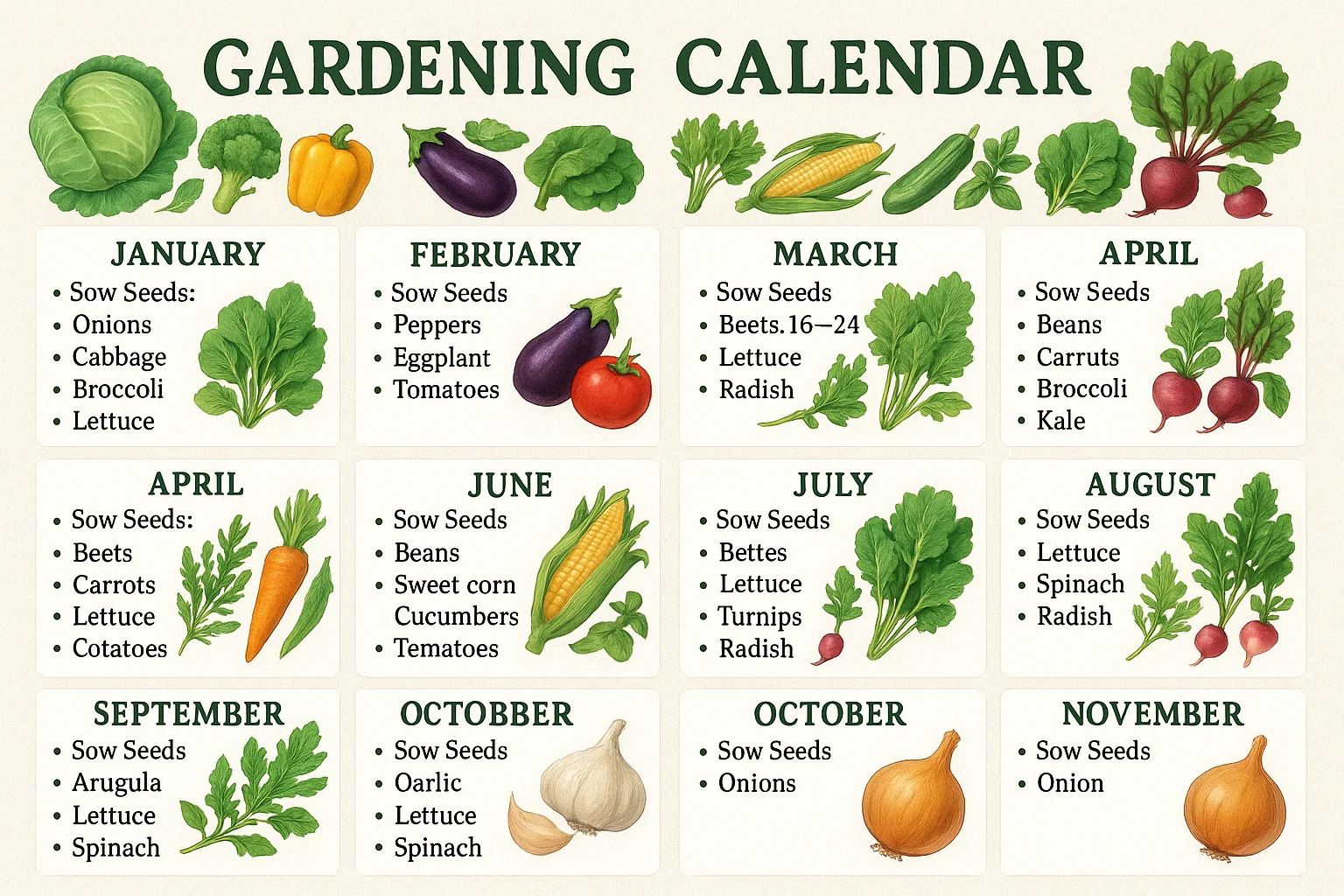
🌿 January – February: Early Start for Long-Season Crops 🌷
What to Start: Begin seeds for slow-growing plants like tomatoes, peppers, and eggplants indoors. 🍅🌶️
Why: These crops need a long growing season, so starting them early ensures they have enough time to mature. 🌞
🌸 March: Start Spring Veggies and Flowers 🌻
What to Start: Start seeds for broccoli, cauliflower, cabbage, and flowers like marigolds and sunflowers. 🌼🌻
Why: These plants thrive in cooler temperatures and should be started indoors 6-8 weeks before your last frost. ❄️
🌿 April: Transition to Warm-Weather Crops 🌞
What to Start: Start seeds for beans, cucumbers, pumpkins, and squash indoors. You can also sow cool-season flowers like pansies directly outdoors. 🍅🥒🎃
Why: These crops do well when the weather warms up, and starting them indoors gives them a head start. 🌞
🌼 May: Time for Outdoor Sowing 🌻
What to Start: Directly sow crops like carrots, peas, lettuce, spinach, and radishes outdoors. 🥕🥬
Why: These plants are hardy and can handle the cooler spring weather, making them perfect for direct sowing in the ground. 🌱
🌞 June: Focus on Summer Crops 🌷
What to Start: This is the ideal time to sow seeds for heat-loving plants like beans, corn, and melons directly outdoors. 🌽🍉
Why: Warm soil is necessary for these plants to germinate, making June the perfect month for sowing them. 🌞
🌻 July: Plant for Fall Harvest 🍂
What to Start: Start seeds for fall crops like kale, Brussels sprouts, and cabbage indoors or outdoors, depending on your climate. 🌱🌽
Why: These crops need a long growing season, and starting them in mid-summer ensures they mature by fall. 🍁
🍂 August: Prepare for Late-Season Growth 🍁
What to Start: Sow seeds for fall crops like radishes, turnips, and winter squash directly outdoors. 🥕🍠
Why: These fast-growing crops can thrive in cooler late-season temperatures, providing a harvest into the fall. 🍃
🍁 September – October: Fall and Winter Crops 🌾
What to Start: Start planting for winter with hardy greens like spinach, lettuce, and Swiss chard. Consider direct sowing hardy flowers too. 🍃🌾
Why: These crops can withstand frost, giving you fresh greens throughout the cooler months. ❄️
By following this month-by-month seed starting guide, you can ensure that your garden gets a head start each season, producing abundant crops and vibrant flowers. Adjust the timeline based on your region’s frost dates and growing conditions for the best results! 🌿
📅 Tips for Using Your Seed Starting Calendar Effectively 🌱
Using a seed starting calendar can significantly improve your gardening success. 🌷 To make the most of it, here are some practical tips: 🌻
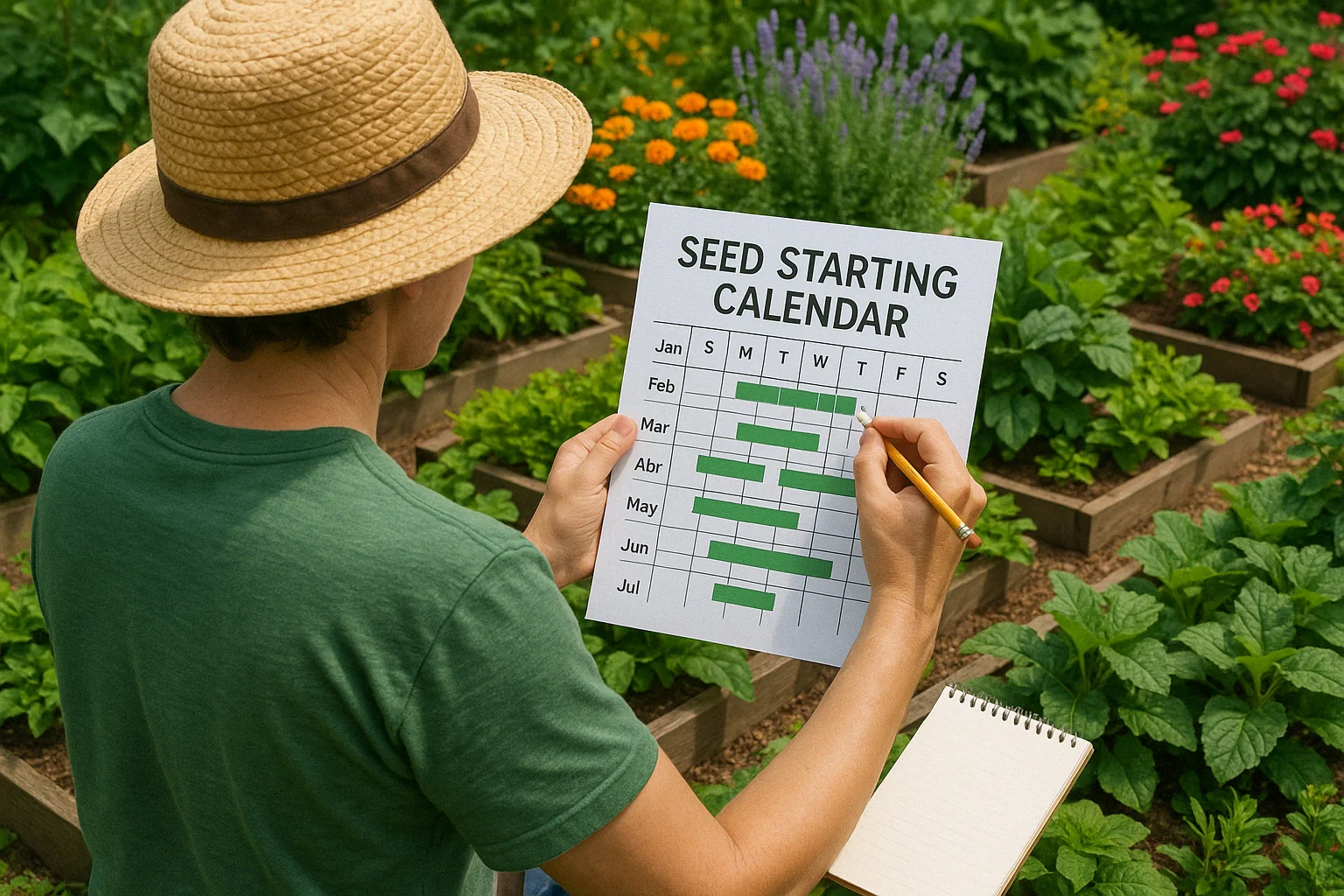
🌞 Plan Ahead 🌱
Review your calendar regularly to ensure you’re starting seeds on time. Knowing your last frost date helps you determine when to start seeds indoors for a successful transplant. 📅
🌱 Group Plants by Timing 🌸
Different plants require different start times. Group your plants by similar germination and transplant dates to simplify your schedule. For example, early spring crops like tomatoes and peppers need to be started indoors earlier than summer crops like cucumbers. 🥒🌞
🌷 Track Plant Growth 🌿
Note the days to maturity and adjust your calendar as needed. If a plant grows faster or slower than expected, it can help you recalibrate for future planting seasons. 🌸
⏰ Use Reminders 🗓️
Set reminders for key dates, such as when to start seeds and when to transplant them outdoors. Timely action is crucial for healthy plants. 🌱
🌞 Review the Weather 🌸
Keep an eye on local weather patterns to adjust your calendar. Unpredictable cold snaps or early warm spells can impact your planting times. 🌤️
📖 Stay Organized 🌱
Keep a gardening journal alongside your calendar. This will help you track the success of your plants year after year and improve your future planting strategies. 📚
By following these simple tips, you can use your seed starting calendar effectively and grow a successful, healthy garden. 🌿
🌿 Common Mistakes to Avoid 🌻
When caring for a Tomatillo plant, it’s essential to avoid common mistakes that can hinder its growth and fruit production. 🌱 Here are some key missteps to watch out for: ⚠️
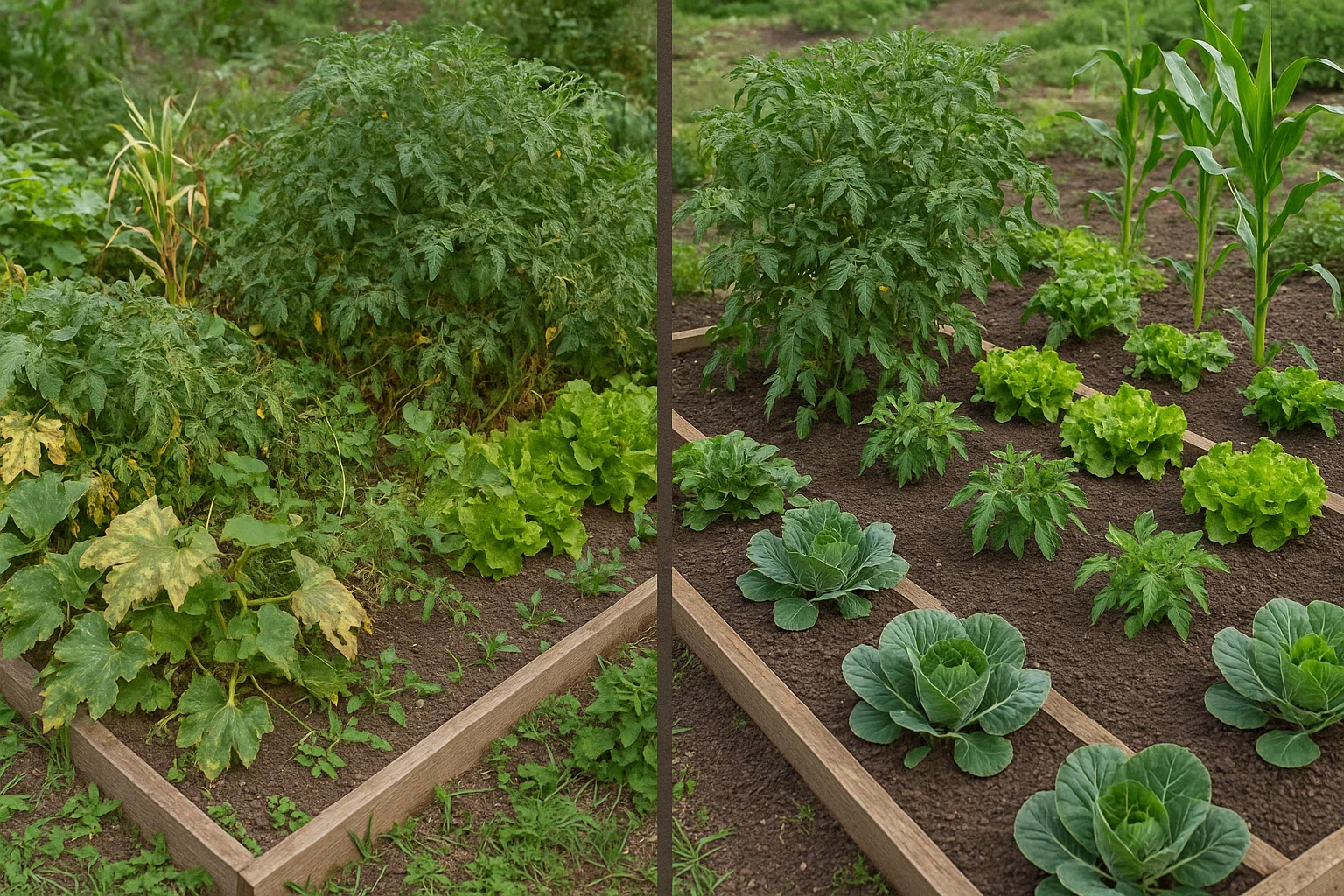
💧 Overwatering 🌿
Tomatillos prefer well-drained soil, so avoid keeping the soil soggy. Overwatering can lead to root rot and other issues. Water only when the top inch of soil feels dry. 🌊
🐝 Neglecting Pollination 🌸
While Tomatillo plants are self-pollinating, they require other plants nearby to maximize fruit production. Planting multiple tomatillo plants will increase your chances of good pollination. 🌼
🌞 Inadequate Sunlight 🌻
Tomatillos need full sun to thrive. Make sure they get at least 6-8 hours of direct sunlight daily. Insufficient sunlight can lead to poor growth and fewer fruits. ☀️
🌿 Not Supporting the Plant 🌾
Tomatillo plants can grow tall and become top-heavy, especially when bearing fruit. Use stakes or cages to support the plant and prevent it from breaking. 🌱
🌱 Planting Too Close Together 🌷
Overcrowding can stunt plant growth and lead to poor air circulation. Ensure there’s adequate space (about 18-24 inches between plants) for healthy growth. 🌿
By avoiding these common mistakes, your Tomatillo plant will have the best chance of thriving and producing a bountiful harvest! 🌸
🌱 Final Thoughts 🌸
Creating and following a seed starting calendar guide is one of the best ways to ensure a thriving, successful garden. 🌻 By understanding the timing of when to start your seeds and when to transplant them outdoors, you can optimize plant growth and avoid common mistakes that often hinder seedlings. 🌿

With careful planning and a clear understanding of frost dates, plant types, and local climate conditions, you’ll be well on your way to cultivating a garden full of healthy, productive plants. 🌷
Remember, a little preparation and attention to detail go a long way in gardening. So, start by creating your personalized seed starting calendar, and soon you’ll be reaping the rewards of your hard work with an abundance of vibrant plants throughout the season. 🌻 Happy gardening! 🌱
Frequently Asked Questions (FAQ)
What is a seed starting calendar guide?
A seed starting calendar guide is a tool that helps gardeners plan the best times to start seeds indoors based on their local climate, the type of plants they want to grow, and their region’s last frost date. It provides a timeline for sowing seeds, ensuring optimal growth and a successful garden.
Why is a seed starting calendar important?
A seed starting calendar is essential because it helps you determine the ideal time for planting seeds indoors, so they have enough time to grow strong before being transplanted outdoors. Proper timing ensures your plants are not too young or too mature when it’s time to move them into your garden.
How do I create a seed starting calendar?
To create a seed starting calendar, first determine your region’s last frost date, then choose the plants you want to grow. Research the recommended planting dates for those plants, counting backward from the last frost date to figure out when to start seeds indoors. Make sure to factor in the growing time for each plant type.
Can I use a seed starting calendar for all types of plants?
Yes, a seed starting calendar guide can be adapted for nearly all types of plants, but different plants may have different needs. Warm-season crops, like tomatoes and peppers, require an earlier start indoors compared to cool-season crops, like lettuce or peas. Always check individual plant requirements.
How accurate is the seed starting calendar guide?
The accuracy of the seed starting calendar depends on your local climate and conditions. While the guide offers general timing based on frost dates and plant needs, it’s important to adjust for your personal gardening environment. Keep track of weather patterns to make timely adjustments if needed.
Can I adjust my seed starting calendar for unusual weather patterns?
Yes, your seed starting calendar guide can be adjusted based on unusual weather patterns. For example, if an early frost is predicted, you may need to delay planting, or if the weather is unusually warm, you might start earlier than planned. Stay flexible and monitor local forecasts to ensure the best timing for your plants.
When should I start seeds for vegetables and flowers?
Start vegetables like tomatoes, peppers, and cucumbers indoors about 6-8 weeks before the last frost date. For flowers like marigolds, zinnias, or petunias, 8-10 weeks before the last frost is usually recommended. However, always refer to the specific plant instructions for the most accurate timing.
How do I know when to transplant seedlings outdoors?
The best time to transplant seedlings outdoors is after the danger of frost has passed and when the soil temperature is warm enough for the specific plants. A good rule of thumb is to wait until the seedlings are strong enough to survive outside conditions, with at least two sets of true leaves.

